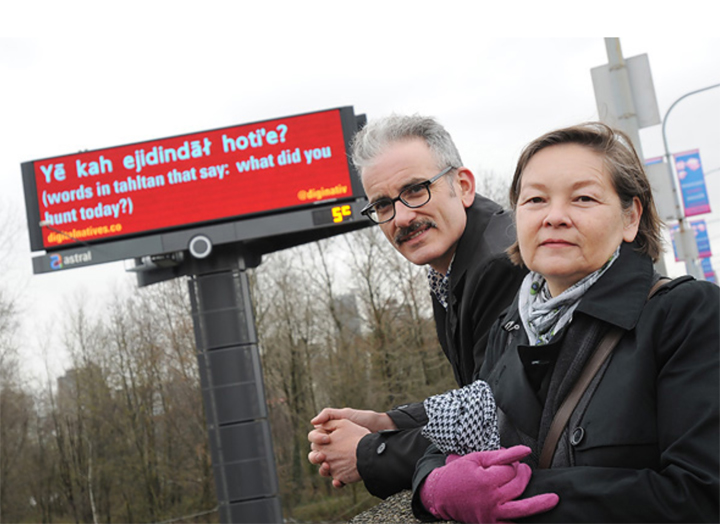Twitter-like messages highlight Vancouver billboard

Aboriginal artists contribute messages
By Cheryl Rossi, Staff writer April 5, 2011
Interspersed with ads for Air Canada, Starbucks, cars and wine on the controversial electronic billboards adjacent to the Burrard Bridge, new messages are provoking thought in a different way.
“My great-grandfather hid his ceremonial regalia in a cave that we have long since lost track of. Who wants to go spelunking? #potlatch ban,” reads a message in teal script on red.
Another features a handful of words in an aboriginal language before changing to: “Words in Tahtlan that say: What did you hunt today?”
These Twitter-like messages are part of a public art project called Digital Natives that will broadcast the messages until the end of the month. It’s the creation of Clint Burnham, a poet, art critic and English professor at Simon Fraser University and Vancouver curator and artist Lorna Brown.
Burnham jogged by the billboards in 2009 shortly after they were erected and saw a canvas for public art. With Brown enlisted as co-curator, they sought help from Other Sights for Artists’ Projects, a non-profit sponsor of public art in Vancouver, including videos on the city-owned panels at Robson and Granville streets and the bulldozer built from scavenged material near the Olympic Village.
With a Canada Council for the Arts grant and a commission from the city for its 125th birthday April 6, organizers of Digital Natives recruited aboriginal and non-aboriginal writers and artists from across North America and aboriginal youth to contribute 140-character messages, the maximum size of a single message that can be posted on Twitter.
They bought ad space from Astral Media, which operates the billboards, which in turn sit on land owned by the Squamish Nation.
The name for the project comes from communications theory that refers to younger people who’ve grown up with digital and online media as digital natives and an older demographic, dubbed digital immigrants, who’ve discovered online and social media tools later in life. The title also refers to aboriginal people who work with digital media.
Of the 30 artists enlisted, only seven, including Burnham and Brown, were on Twitter. The others simply emailed their messages.
None of the approximately 20 youth, most of whom are poor, that Burnham conducted workshops with at the Native Education College on East Fifth Avenue were on Twitter or owned expensive smart phones.
“If you’re from a rural, community, you probably don’t have broadband there,” Burnham said.
But the youth owned cellphones and were avid texters. Two workshops generated six cheeky and political messages for the billboard, Burnham said, one questioning the concept of having “status” and another that questions the label “aboriginal.”
Many of the messages received by Digital Natives were translated into Kwak’wala and Squamish.
“There are only 15 highly proficient speakers of Squamish today,” Burnham said.
Translations were also restricted to 140 characters.
Organizers have asked Henry Charles, the Vancouver Public Library’s First Nations storyteller in residence, to translate messages into Musqueam.
Other messages were submitted in two languages, including Tahtlan, Thompson, French and Chinook, a trading jargon that spread across British Columbia in the 19th century.
The project hit a roadblock just as it was about to go live this week when Astral Media asked for translations of the messages it was given two weeks ago and initially held back 25 of the posts, according to Burnham. As a result, messages in Squamish weren’t seen on Squamish land where the billboards are rooted, and the Kwak’wala message that included English Twitter-speak “OMG” for oh my God wasn’t posted.
“It’s like cutting a few scenes out of a film or something, or pages out of a book,” Burnham said.
Astral did not return a call from the Courier Tuesday morning, but decided Tuesday afternoon, according to Burnham, that it would run all but three of the messages.
The company won’t post “Your grandparents’ unacknowledged debts return to you as rage against the car in front,” which was written by novelist and poet Larissa Lai, in English or Squamish.
It also won’t post “Imperial Canada awarded sex abuse to native youth by the black robes now proudly bestows bronze silver gold medals with Indian image,” written by American Indian artist Edgar Heap of Birds in all capital letters. Public art by Heap of Birds is permanently displayed at SFU and the University of B.C.
“This message is provocative, and perhaps contentious, but Astral’s refusal to run it seems to ignore the role of art in our society, which surely is to initiate a dialogue, to get us thinking, and perhaps to talk about unpleasant histories,” Burnham said.
New messages, including tweets from the public, are to be added in the second half of the month. Digital Natives continues to accept submissions.
Not all of the messages generated for Digital Natives will be broadcast on billboards but will be available at digitalnatives.othersights.ca.
While the rapid advancement of new technologies forges digital divides, Burnham also sees online tools being used to preserve dying languages. The Squamish Language site (squamishlanguage.com) matches photos of an item with audio of the related Squamish word.
A symposium on the project runs May 1 at the Museum of Anthropology from 1 to 5 p.m. Heap of Birds will attend.
crossi@vancourier.com
Twitter: @Cheryl_Rossi
© Copyright (c) Vancouver Courier